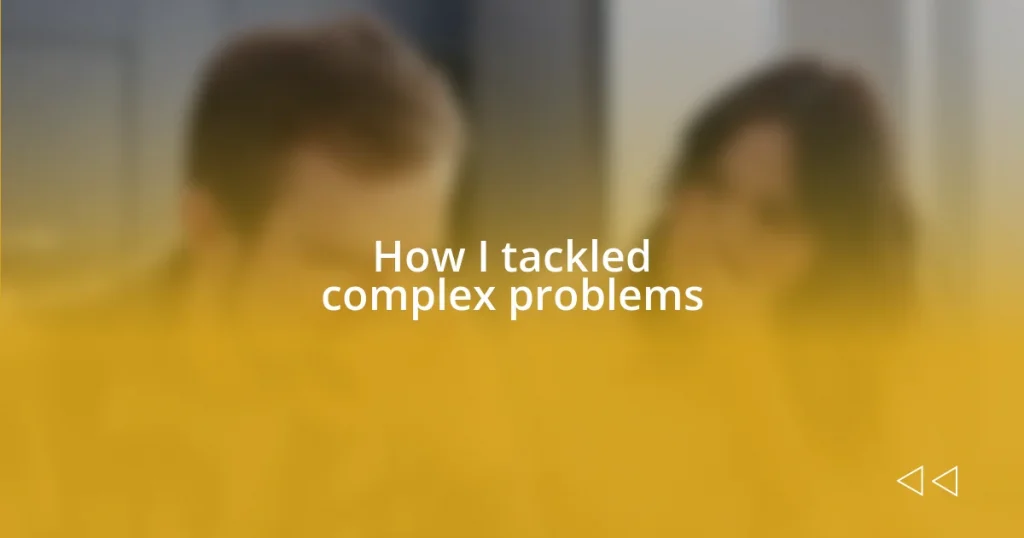Key takeaways:
- Effective complex problem solving requires gathering diverse perspectives and fostering collaboration to align varied insights towards a common goal.
- Thorough analysis of potential solutions should involve understanding their implications, not just quantifying results, to make informed decisions.
- Evaluating outcomes and embracing adaptability fosters continuous learning and resilience, which are essential for tackling future challenges effectively.

Understanding complex problem solving
Complex problem solving is like peeling back the layers of an onion – the deeper you go, the more intricate the issues become. I remember a particularly challenging project where I had to coordinate multiple teams with differing agendas. It felt overwhelming at times, and I often asked myself, “How do I even begin to align everyone toward a common goal?”
As I delved into the problem, I realized that understanding the diverse perspectives of each team was crucial. It struck me that every person brought unique insights and experiences to the table, which, when harmonized, could illuminate pathways forward that I hadn’t considered initially. This experience reminded me that communication is key; it’s not just about solving the problem, but also about fostering collaboration.
When facing complex issues, I often find it helpful to break them down into smaller, more manageable components. I recall taking a spreadsheet of jumbled data and sorting it into categories. Suddenly, what once appeared to be chaos transformed into a clear visual map of solutions, illuminating paths I hadn’t noticed. Isn’t it fascinating how clarity can emerge from confusion when we approach challenges thoughtfully?

Identifying the problem clearly
Identifying a problem clearly often feels like trying to find a needle in a haystack. During one project, I was tasked with addressing a client’s declining sales. Initially, the issue seemed straightforward. Yet, as I dove deeper, I realized that the root cause was not just low numbers but also included factors like market demand, customer feedback, and even internal team morale. This experience taught me that the clarity of perception can drastically alter the strategy you adopt.
To refine my understanding of a problem, I usually consider the following steps:
- Gather diverse perspectives: Engage with team members across different roles to capture varied insights.
- Ask probing questions: What are the symptoms? What have we tried before? What results did those efforts yield?
- Identify patterns and trends: Look for recurring themes in data or feedback that indicate where the core issue lies.
- Prioritize issues: Determine which problems are most pressing and which will have the most significant impact if solved.
This process not only makes the problem tangible but also fosters a collaborative environment. The moment I started viewing the situation through a broader lens, I felt a weight lift off my shoulders, transforming confusion into clarity and giving me a renewed sense of purpose.

Gathering relevant information effectively
Gathering relevant information effectively can be a game-changer in tackling complex problems. I remember during a particularly intricate project, I spent a weekend reviewing industry reports and customer surveys to understand market trends better. I was surprised to see how a small detail in customer feedback could highlight an overlooked opportunity. This experience drove home the point that rigorous information gathering isn’t just beneficial; it’s essential.
Being organized in my approach to collecting information has proven invaluable. For instance, I created a visual mind map to connect various sources of data and insights. The more I linked these pieces together, the clearer the whole picture became. Suddenly, I could see how interconnected factors influenced our challenges. It was as though I flipped a switch, illuminating connections I hadn’t noticed before. Does that resonate with you? Have you ever found clarity in an unexpected place through thoughtful information gathering?
I also found that reaching out to experts in the field can really broaden my understanding. I’ll never forget my conversation with a seasoned mentor who shared their experiences and the pitfalls they encountered. It was a real eye-opener, reminding me that gathering relevant information isn’t just about collecting data—it’s about leveraging the wisdom of others. Each interaction brings fresh perspectives and helps build a robust strategy for navigating the complexities at hand.
| Information Gathering Technique | Effectiveness |
|---|---|
| Industry Reports | Highlights market trends and offers data-driven insights |
| Customer Feedback | Uncovers unmet needs and opportunities for improvement |
| Networking with Experts | Gains invaluable wisdom and perspective from experienced professionals |
| Visual Mapping | Clarifies relationships and interdependencies among various factors |

Analyzing potential solutions thoroughly
Analyzing potential solutions thoroughly is like peeling an onion—there are layers to uncover, and often, the more you dig, the more you reveal. I recall a challenging phase during a project where we needed to choose between two different marketing strategies. Instead of rushing into a decision, I gathered my team for a brainstorming session. By mapping out pros and cons on a whiteboard, we could visualize how each option aligned with our goals. This collective effort brought to light some surprising insights that might have otherwise gone overlooked.
What I’ve learned about analysis is that it’s not just about quantifying results; it’s about understanding the implications of each potential solution. In one instance, we were evaluating two software options for client management. By diving deep into user reviews and conducting trials with both tools, we discovered subtle differences that ultimately influenced our decision. These nuances, such as user-friendliness and integration capabilities, made a world of difference. Have you ever chose a solution just based on price without exploring its real impact? I know I have, only to face challenges down the road that could have been avoided with thorough analysis.
Additionally, I find it invaluable to take a step back and challenge my own assumptions. When working on a project for a non-profit organization, we initially thought a large-scale campaign would yield the best results. However, after careful analysis, we realized that targeted local outreach might resonate more with the community. This shift in strategy not only saved resources but also achieved greater engagement. Reflecting on these experiences reassures me that true analysis is iterative; it requires honesty, adaptability, and sometimes, a willingness to pivot based on what the data reveals.

Implementing chosen solutions strategically
When it comes to implementing chosen solutions, I’ve found that a strategic approach can make all the difference. For example, during a product launch, I not only planned the rollout step-by-step but also aligned my team’s strengths with each task. It was a careful balancing act, but seeing everyone in their sweet spots energized the whole project. Sometimes, I wonder, how many times do we rush execution without considering who’s best suited to tackle each aspect?
I also believe that clear communication is vital in this phase. I recall a time when I led a team that was scattered across different locations. By using collaboration tools and regular check-ins, I ensured everyone was on the same page as we implemented our strategies. It’s amazing how much smoother things run when there’s a consistent dialogue. Have you ever faced misunderstandings that could have been avoided with a simple chat? Those moments remind me that transparency fosters trust and keeps the momentum going.
Another lesson I’ve learned is the importance of being flexible. I vividly remember a project where we had to adjust our strategy mid-implementation due to unexpected market changes. Rather than viewing it as a setback, I encouraged my team to brainstorm alternative solutions. The spontaneity sparked creativity, and we ended up with a modified approach that exceeded our expectations. How often do we cling too tightly to a plan instead of embracing opportunities for innovation? Embracing adaptability in our strategies can lead us down paths that we never even considered before.

Evaluating outcomes and learning
Evaluating outcomes is crucial in understanding what worked and what didn’t. I remember a time after launching a new website. We had high hopes for user engagement, but the numbers didn’t match our expectations. By analyzing user feedback and behavior analytics, we identified navigation issues that drove visitors away. Have you ever poured your heart into something only to find out it could have been better with a little more scrutiny? I know those moments can sting, but they also reveal valuable lessons.
Through this process, I’ve come to appreciate the power of introspection. After a recent project, I gathered my team for a candid feedback session. It was eye-opening to hear varying perspectives on what had resonated and what fell flat. Often, it’s easy to celebrate successes without deconstructing them. The emotional richness of those discussions reinforced our strengths and highlighted areas for improvement. Have you ever gained more from a failure than a success? I find that those “teachable moments” often shape our future approaches.
I also believe that continuous learning should be a priority after evaluating outcomes. Reflecting on our experiences allows us to pivot effectively in future projects. For instance, after noticing a pattern of miscommunication in several initiatives, I took it upon myself to incorporate structured debriefs. These have transformed our teamwork from reactive to proactive. Isn’t it fascinating how small adjustments can lead to significant shifts in performance? Each evaluation becomes an opportunity to evolve, creating a culture of growth within the team.

Adapting for future challenges
When it comes to adapting for future challenges, I find that cultivating resilience is key. I once faced a scenario where a major client shifted their priorities just days before we were set to deliver a comprehensive report. Instead of panicking, I gathered my team for an impromptu brainstorming session. It was incredible to see how quickly we pivoted our approach, turning a potential crisis into an opportunity for innovation. Have you ever had to navigate a sudden change like that? Those moments challenge us but also remind us of our capacity to rise to the occasion.
Another crucial aspect involves anticipating potential roadblocks. I distinctly recall a project where we launched a new marketing campaign but overlooked the timeline for regulatory approvals. The delay put us behind schedule, leading me to rethink our planning process. I learned then the importance of including contingency plans that account for external factors. It’s amazing how being prepared for the unexpected can save us from undue stress later. Have you considered what risks might derail your current plans? I’ve found that simply asking this question can open up a treasure trove of insights.
Lastly, I believe in the transformative power of diverse perspectives. During a strategic meeting, I invited team members from different departments to share their insights on tackling an upcoming project. The varied viewpoints led to a rich discussion and a more comprehensive plan. I sometimes wonder how many brilliant ideas get lost simply because we don’t reach beyond our immediate teams. Do you actively seek feedback from others? Embracing a collaborative mindset not only nurtures creativity but also strengthens our ability to adapt to new challenges as they arise.















